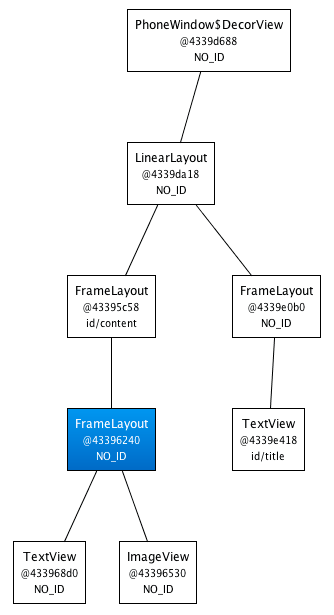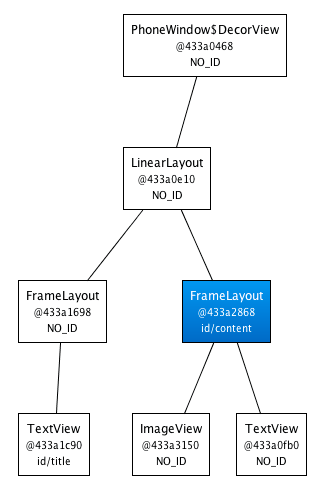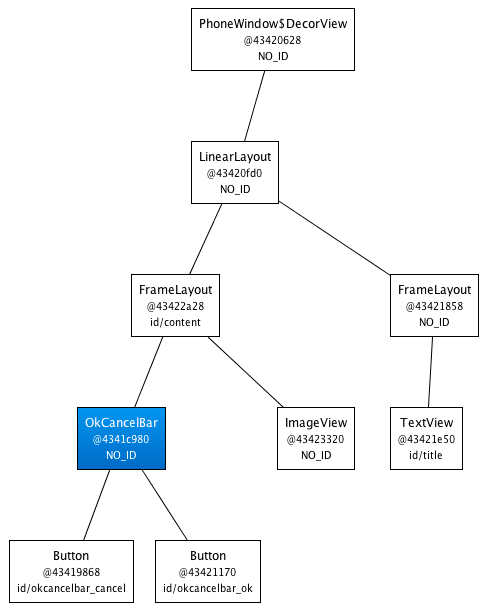<merge />标签用于减少View树的层次来优化Android的布局。通过看一个例子,你就能很容易的理解这个标签能解决的问题。下面的XML布局显示一个图片,并且有一个标题位于其上方。这个结构相当的简单;FrameLayout里放置了一个ImageView,其上放置了一个TextView: ????布局渲染起来很漂亮,而且看不出有什么问题: ????当你使用HierarchyViewer工具来检查时,你会发现事情变得很有趣。如果你仔细查看View树,你将会注意到,我们在XML文件中定义的FrameLayout(蓝色高亮显示)是另一个FrameLayout唯一的子元素: ????既然我们的FrameLayout和它的父元素有着相同的尺寸(归功于fill_parent常量),并且也没有定义任何的background,额外的padding或者gravity,所以它完全是无用的。我们所做的,只是让UI变得更为复杂。怎样我们才能摆脱这个FrameLayout呢?毕竟,XML文档需要一个根标签且XML布局总是与相应的View实例想对应。 这时候,<merge />标签闪亮登场了。当LayoutInflater遇到这个标签时,它会跳过它,并将<merge />内的元素添加到<merge />的父元素里。迷惑了吗?让我们用<merge />来替换FrameLayout,并重写之前的XML布局: ????新的代码中,TextView和ImageView都直接添加到上一层的FrameLayout里。虽然视觉上看起来一样,但View的层次更加简单了: ????很显然,在这个场合使用<merge />是因为Activity的ContentView的父元素始终是FrameLayout。如果你的布局使用LinearLayout作为它的根标签(举例),那么你就不能使用这个技巧。<merge />在其它的一些场合也很有用的。例如,它与<include />标签结合起来就能表现得很完美。你还可以在创建一个自定义的组合View时使用<merge />。让我们看一个使用<merge />创建一个新View的例子——OkCancelBar,包含两个按钮,并可以设置按钮标签。下面的XML用于在一个图片上显示自定义的View: 新的布局效果如下图所示: ???????OkCancelBar的代码很简单,因为这两个按钮在外部的XML文件中定义,通过LayoutInflate类导入。如下面的代码片段所示,R.layout.okcancelbar以OkCancelBar为父元素: ????两个按钮的定义如下面的XML所示。正如你所看到的,我们使用<merge />标签直接添加两个按钮到OkCancelBar。每个按钮都是从外部相同的XML布局文件包含进来的,便于维护;我们只是简单地重写它们的id: ????我们创建了一个灵活且易于维护的自定义View,它有着高效的View层次: <merge />标签极其有用。然而它也有以下两个限制: ·?????????<merge />只能作为XML布局的根标签使用 ·?????????当Inflate以<merge />开头的布局文件时,必须指定一个父ViewGroup,并且必须设定attachToRoot为true(参看inflate(int, android.view.ViewGroup, Boolean)方法)。 转自:http://blog.sina.com.cn/s/blog_4d661a8c0100mnun.html<FrameLayout xmlns:android="http://schemas.android.com/apk/res/android"????android:layout_width="fill_parent"????android:layout_height="fill_parent">????<ImageView?????????android:layout_width="fill_parent"????????android:layout_height="fill_parent"????????android:scaleType="center"????????android:src="@drawable/golden_gate" />????<TextView????????android:layout_width="wrap_content"????????android:layout_height="wrap_content"????????android:layout_marginBottom="20dip"????????android:layout_gravity="center_horizontal|bottom"????????android:padding="12dip"????????android:background="#AA000000"????????android:textColor="#ffffffff"????????android:text="Golden Gate" /></FrameLayout>

<merge xmlns:android="http://schemas.android.com/apk/res/android">????<ImageView?????????android:layout_width="fill_parent"????????android:layout_height="fill_parent"????????android:scaleType="center"????????android:src="@drawable/golden_gate" />????<TextView????????android:layout_width="wrap_content"????????android:layout_height="wrap_content"????????android:layout_marginBottom="20dip"????????android:layout_gravity="center_horizontal|bottom"????????android:padding="12dip"????????android:background="#AA000000"????????android:textColor="#ffffffff"????????android:text="Golden Gate" /></merge>
<merge????xmlns:android="http://schemas.android.com/apk/res/android"???xmlns:okCancelBar="http://schemas.android.com/apk/res/com.example.android.merge">????<ImageView?????????android:layout_width="fill_parent"????????android:layout_height="fill_parent"????????android:scaleType="center"????????android:src="@drawable/golden_gate" />????<com.example.android.merge.OkCancelBar????????android:layout_width="fill_parent"????????android:layout_height="wrap_content"????????android:layout_gravity="bottom"????????android:paddingTop="8dip"????????android:gravity="center_horizontal"????????android:background="#AA000000"????????okCancelBar:okLabel="Save"????????okCancelBar:cancelLabel="Don't save" /></merge>
public class OkCancelBar extends LinearLayout {????public OkCancelBar(Context context, AttributeSet attrs) {????????super(context, attrs);????????setOrientation(HORIZONTAL);????????setGravity(Gravity.CENTER);????????setWeightSum(1.0f);????????LayoutInflater.from(context).inflate(R.layout.okcancelbar, this, true);????????TypedArray array = context.obtainStyledAttributes(attrs, R.styleable.OkCancelBar, 0, 0);???????????????String text = array.getString(R.styleable.OkCancelBar_okLabel);????????if (text == null) text = "Ok";????????((Button) findViewById(R.id.okcancelbar_ok)).setText(text);????????text = array.getString(R.styleable.OkCancelBar_cancelLabel);????????if (text == null) text = "Cancel";????????((Button) findViewById(R.id.okcancelbar_cancel)).setText(text);?????????array.recycle();????}}<merge xmlns:android="http://schemas.android.com/apk/res/android">????<include????????layout="@layout/okcancelbar_button"????????android:id="@+id/okcancelbar_ok" />???????????<include????????layout="@layout/okcancelbar_button"????????android:id="@+id/okcancelbar_cancel" /></merge>
详细解决方案
Android格局技巧——合并布局
热度:66 发布时间:2016-05-01 16:31:51.0
相关解决方案
- android 读取byte[]中的元素解决方案
- android 标题栏兑现方式
- android 中Activity向BroadcastReceiver发送数据,该怎么解决
- Android 4.0 为什么模拟器老是提示小弟我谷歌拼音输入法已停止
- android:getSharedPreferences() 这是哪个类的方法解决思路
- android 怎么判断一个程序是否联网
- android 大量数据按周分组,该如何解决
- android RadioButton如何设置默认选中
- ksoap2-android-这个包,连接webService怎么设置超时
- android 怎么重新设置锚点
- android UI界面设计解决方案
- android 图片对象获取的有关问题
- android 怎么调用淘宝支付宝接口
- Android 沿袭InputMethodService自定义输入法
- android 关于服务连接的疑义
- android 两个activity如何通信
- android 怎么实现对view的放大和缩小
- android 教程解决方法
- android ID,该如何处理
- 准备复习2-3个月,看java+android,请问有经验者,怎么看效果最好》
- android UI线程与AsyncTask的有关问题
- android(java)中的java.net能不能和c#的system.net.sockets进行tcp通信,该如何解决
- android ListView 中的onItemClick Intent 没法跳转
- android(java) 中文乱码的有关问题
- c#c++,android,ios(iphone),php,java视屏课程 散分
- android Post文件到ASP.NET的有关问题,能收到参数收不到文件
- RIM 替 Android 开发者提供免费的 PlayBook!2月13日前
- android 动态设立控件高度
- Android test project 编译方法
- android -相机使用教程(1)解决方法